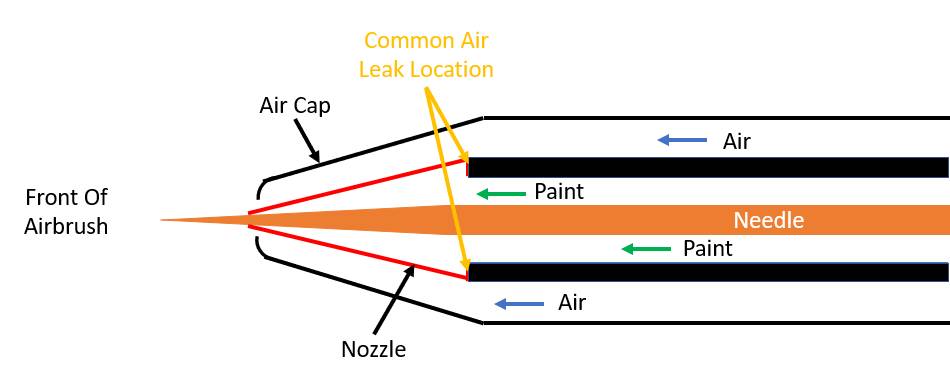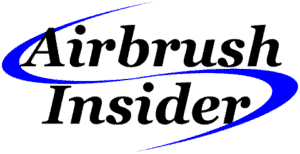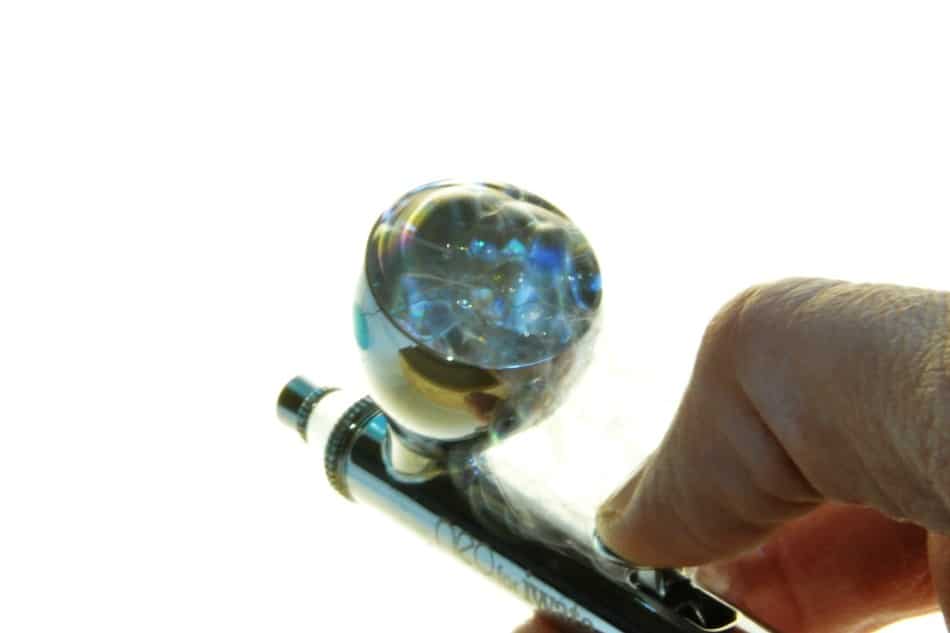A problem commonly faced when working with an airbrush is bubbles filling the paint cup / bottle during use… You know, Bubbles forming within the paint due to air making its way into the paint chamber…
While, this can be quite frustrating, and make you feel as if your airbrush is done for. Don’t go throwing the airbrush across the room just yet. Odds are the fix is much simpler then you may think.
Today we will be discussing what causes bubbles in the paint cup of your airbrush, and how to go about fixing the issue…
Put simply:
An airbrush will blow bubbles in the paint cup if there is any sort of weak seal between the air chamber, and paint chamber pre atomization. Bubbles form because pressurized air seeps into the paint chamber and has no other point of exit but through the paint cup. Continue on to learn how to troubleshoot the issue.
Nonetheless, the culprits that cause bubbles in the paint cup of an airbrush can be extensive. However, the most common are as follows:
- Damaged, Cut, Or Incorrectly Placed Seals / Gaskets
- Damaged Needle Or Nozzle Components
- Loose Nozzle and/or Other Head Components
- Excessive Tip Dry Or Paint Build Up Near The Nose Of The Airbrush
Now, before I get to far ahead of my self, let’s further explain why you are getting bubbles in the paint cup of your airbrush so you can better understand what may be causing the issue to begin with.
We’ll dive deep into the solutions shortly there after.
Why An Airbrush Blows Bubbles
In order to fully grasp why your airbrush is bubbling in the paint cup, its best that you first understand how an airbrush works if you don’t already know. But in short an airbrush works as follows:
The air and paint are separated in their own individual chambers within the airbrush, up until the tip of the nozzle where the air then atomizes the paint as it flows out of the nozzle. The needle is used similarly to a cork but in this case it is a mechanical cork. Meaning, when you pull back on the airbrush trigger the needle is then pulled back, opening the nozzle, and allowing paint to flow…
If any one of the seals within the chambers separating the air from the paint are to fail, its likely the air will then use that faulty seal gap as a path of least resistance. Resulting in air making its way out through the inlet of the paint chamber, instead of out the tip of the airbrush. Causing bubbles to form inside the paint cup / bottle.
Check the diagram below for further illustration.

Now, there are 3 major causes for one to be experiencing blowback (bubbles in the paint cup) while airbrushing, and all 3 have something to do with the airbrush nozzle.
The most common causes for bubbles in the paint cup are as follows:
Damaged / Missing Seals
90% of the time blowback occurs due to an improper connection between the airbrush nozzle, and the airbrush body. Not having a tight seal here will result in an air leak.
The reason why you see bubbles in the paint cup / bottle is because air is finding a way (before reaching the outlet of the airbrush nozzle) into the paint chamber. This is likely going to be due to a faulty seal / connection between the nozzle and the airbrush body.
However, Its important to note, there are a few different methods manufacturers use when it comes to attaching / seating the nozzle onto the airbrush body. Some utilize threads, while others utilize pressure from another part (such as the air cap) to seat the nozzle.
That being said its possible your model of airbrush doesn’t require the use of a seal between the nozzle and body of the airbrush. In this case its possible gunk could be in the way preventing a proper connection between the airbrush nozzle, and the body.
Nonetheless, a majority of the nozzle configurations out there will utilize a seal of sorts and if its missing or damaged, there is no question air will be escaping through that connection.
Loose Components
Related to the previous cause.
If the airbrush nozzle, or air cap is loose / not threaded on tight enough it can result in a false seal between the nozzle and the airbrush body.
This can be quite easy to spot by simply giving a slight nudge on the parts to see if they are seated properly, if you get any movement with very minimal effort odds are the issue is occurring due to loose components.
Simply solve this by tightening any loose components, then re-test to see if bubbles continue to form.
But be very careful not to over tighten any parts, as they are very fragile and can easily sheer off.
Damaged Components
Likely the least common cause, but still happens…
A damaged nozzle, needle, and / or air cap can result in backflow / bubbling in the paint cup / jar.
This is because at some point (before the nozzle outlet) damage has occurred that is allowing air into the paint chamber. This can be from,
- A cracked nozzle
- A bent / flared nozzle
- A badly bent needle
- Or even a damaged air cap
Either way closely examining your parts could present damage in one or the other components. Replacing the damaged part will be vital to get the airbrush back to proper working order.
For you visual learners, below is a video discussing the causes for bubbles forming in the airbrush paint cup / bottle. Do review the video an meet me below for how to go about fixing this problem.
How To Stop An Airbrush From Blowing Bubbles
Assuming you now have a good idea as to what could be causing your airbrush to blow bubbles. Below are a few possible solutions for the problem. I would recommend all to begin with a good cleaning of the airbrush. While doing so, be sure to closely examine each part of the airbrush.
Then of course skip ahead to the solution that you believe will best solve the issue. That is assuming you have a good idea as to what is causing the issue…
If you are unable to detect what the specific cause could be, simply begin at the top of the list and eliminate solutions that don’t solve the problem.
1st: Start With A Good Cleaning
literally 90 – 95% of all problems people experience when using an airbrush is related to a dirty airbrush. Simply doing a deep clean on your airbrush will release any paint that could be blocking passages.
In the case of bubbles forming in the paint cup, it’s possible for a clogged nozzle, or dirty needle to cause this (depending on the model of airbrush your working with).
Either way, any time you experience an issue with your airbrush its best to begin by deep cleaning the airbrush. Often times gunk left behind from the last cleaning is what is causing the issue. Even if its not, its best to start troubleshooting with a well cleaned airbrush.
For a complete walk through on deep cleaning an airbrush due take a look at my article: How to clean an airbrush! There I discuss 2 methods for cleaning an airbrush. The first being a “simple clean” which should be done often, the second being a “Deep clean” which should be done on occasion.
2nd: Check For Damage
This is easiest to do while cleaning the airbrush as you’ll have the airbrush disassembled. But the main components to check are the Nozzle, Needle, & Air cap. If any damage has
That being said, its less common for this symptom to occur due to a damaged part. But that’s not to say it doesn’t happen.
If you do happen to find a damaged part such as a:
- Cracked
- Bent
- Flared
Nozzle, Needle, or air cap? It’s important to get it fixed before continuing on. Odds are its causing the issue. If not, Its contributing to it.
3rd: Ensure Parts Are Tight (But Not Too Tight)
Loose parts can result in many problems. But speaking specifically of the issue you’re experiencing. It’s possible for the airbrush nozzle, and / or air cap to be loose.
If either of these are not seated properly it will result in an air leak, which is the #1 cause when someone is experiencing blowback when airbrushing.
Now, depending on the model of airbrush your using, you may need to check both the nozzle & air cap, or simply the air cap. You see, some airbrush manufacturers utilize what is known as a self centering nozzle (I discussed on this briefly above).
This style relies on the air cap to seat the nozzle into place. In this instance, if the air cap was loose, it would result in an air leak between the airbrush nozzle, and the airbrush body. Simply because the air cap is not applying enough pressure on the nozzle to seat it properly. (Or there is gunk in the way)
However, another common design (typically used by Iwata) will utilize threads for both the nozzle, and air cap. Meaning, the nozzle will thread into the body of the airbrush, and the air cap will thread on over the nozzle.
In this instance, you’ll need to check for a loose nozzle.
Note, If parts feel loose, be sure not to over tighten them when tightening. Over tightening components will surely result in damage… You only need a snug fit.
4th: Check The Seals
If you find all the components on the airbrush are tight, yet you continue to experience bubbles… The next culprit to check is the seal between the nozzle and airbrush body.
Now, given that there are multiple models / designs when it comes to the airbrush, it’s difficult to say exactly what seals your airbrush has, and may need. That being said it’s common for an airbrush to have some sort of seal / gasket / O-ring between the nozzle and airbrush body.
Though self centering nozzles don’t typically have a seal, In this case simply check for any gunk that could be lodged between the nozzle and body connection not allowing the nozzle to seat properly.
But back to the airbrushes that do utilize a seal,
If you find the seal is damaged, shrunk, missing and/or so forth its likely that is the culprit. Air is most likely making its way past that damaged seal resulting in bubbles forming inside the paint cup…
But again, keep in mind some airbrush models don’t utilize a seal in the form of a gasket or o-ring between the nozzle and airbrush body. So your gonna have to know the model of airbrush your working with in order to fully know if seals are missing or not…
Now if you do need replacement seals, they are typically quite easy to find. But if you struggle you should be able to contact the manufacturer for a replacement seal for the model of airbrush your fixing…
Though there are some alternatives that many in the airbrush community use as seals. Though These alternatives are in favor of threaded components…
- Teflon Tape (Available On Amazon)
- Bees Wax (Available On Amazon)
- Lip Balm (Available On Amazon)
Conclusion
As you have likely come to understand, commonly the biggest culprit behind this issue of bubbling inside the paint cup / bottle occurs due to an issue with the airbrush nozzle, and / or the air cap.
For the most part the issue is due to a faulty seal between the nozzle and the airbrush body. However, sometimes it can, and likely will, occur if damage has occurred to the front portion of the airbrush.
Granted, bubbling in the paint cup / bottle can occur due to a mishap during manufacturing, but if this is the case its likely the issue will present its self the moment you use the airbrush for the first time…
Now, getting the bubbles to stop can be as simple as tightening the nozzle and/or air cap, to simply replacing the nozzle.
But for most, this problem should be easily fixed and shouldn’t return with proper maintenance, And periodic replacement of seals.
Anyway, I hope you were able to find some value here! If you have any further questions regarding the airbrush do be sure to take a look around the website. Airbrush Insider is dedicated to helping all in the airbrush community!
This is Colt signing off!
Check Out Some Of My Favorite Airbrush Equipment:

